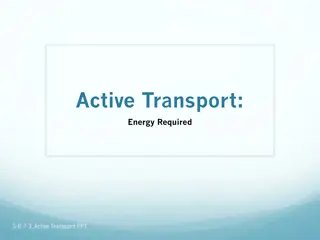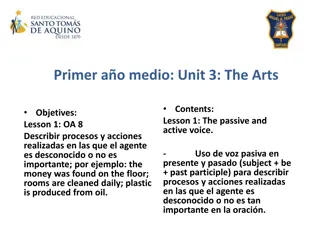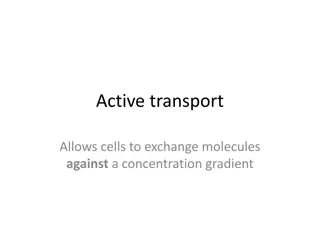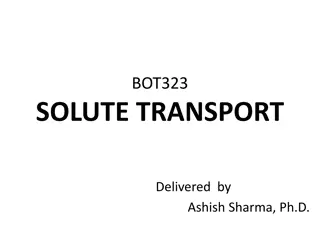Understanding Passive and Active Transport in Cells
Explore the processes of diffusion, osmosis, and active transport in cells. Understand the similarities and differences between them, and learn why active transport is crucial for living organisms. Watch a video on active transport and answer related questions to deepen your knowledge. Enhance your understanding through self-assessment activities and sort statements to distinguish between the processes. Dive into the world of cellular transport mechanisms!
Download Presentation

Please find below an Image/Link to download the presentation.
The content on the website is provided AS IS for your information and personal use only. It may not be sold, licensed, or shared on other websites without obtaining consent from the author. Download presentation by click this link. If you encounter any issues during the download, it is possible that the publisher has removed the file from their server.
E N D
Presentation Transcript
Active Transport Do now activity: 1. Compare the process of diffusion to osmosis, what are the similarities? What are the differences? 2. Think about the term active transport how do you think this process might differ from diffusion and osmosis?
Progress indicators GOOD PROGRESS: To describe the process of active transport To be able to compare the process of active transport to diffusion and osmosis OUTSTANDING PROGRESS: To explain why active transport is an important process for living organisms
Osmosis and diffusion are passive processes, this means substances will always move down a concentration gradient. Low High concentration concentration Active transport is an active process, this means substances are moved against their concentration, from an area of low concentration to an area of high concentration. High Low concentration concentration
Task: Watch the video on active transport and answer the following questions: 1. What is required in order for active transport to take place? 2. What is the name of the structure which carries molecules across the cell membrane during active transport? 3. Which process released the energy needed for active transport? 4. Give an example of a plant cell where active transport commonly takes place. 5. Which organelle is prevalent (more common) in cells that carry out active transport more frequently? https://www.youtube.com/watch?v=eDeCgTRFCbA
Self-assessment: 1. Energy is needed for active transport to occur 2. A protein carrier which spans the cell membrane 3. Respiration releases energy in the form of ATP, this is required for active transport to take place. 4. An example of a plant cell is a root hair cell, this is where mineral ions are actively pumped from the soil into the plant from a low to a high concentration. 5. Mitochondria is more prevalent in cells where active transport occurs more frequently. Mitochondria is the site of respiration in cells, therefore more energy will be released.
Diffusion, osmosis and active transport Task: Sort the following statements into the correct columns. Remember: The statements can apply to more than one process! Diffusion Osmosis Passive process Active process Requires energy Does not require energy Moves molecules against a concentration gradient Move molecules down a concentration gradient Moves substances from a high to a low concentration Moves substances from a low to a high concentration Movement of water only Active Transport
Diffusion Osmosis Active Transport Active process Passive process Passive process Does not require energy Does not require energy Requires energy Moves molecules against a concentration gradient Moves substances down a concentration gradient Moves substances down a concentration gradient Moves substances from a low to a high concentration Moves substances from a high to a low concentration Moves substances from a high to a low concentration Movement of water only
The importance of active transport Active transport is widely used in cells and there are particular examples where this is especially important. Plants often live in soil where mineral ions are usually found in dilute solutions, more dilute than the solution within the plants root hair cells. By using active transport, the plant can still absorb the mineral ions against the concentration gradient.
In humans, an example of active transport is the active absorption of glucose from your gut and kidney tubules into your blood. This is often done against a large concentration gradient. Glucose is needed for respiration so it is important to get as much as possible from the gut. Quick Check: 1. Describe how active transport works in a cell (4 marks) 2. Explain why cells that carry out a lot of active transport also have many mitochondria (2 marks)
Plenary: Past-paper exam question: Epithelial cells carry out active transport. a) Name one food molecule absorbed into epithelial cells by active transport. (1) b) Why is it necessary to absorb some food molecules by actvie transport? (1) c) Suggest why epithelial cells have many mitochondria. (2) d) Some plants also carry out active transport, give on substance that plants absorb by active transport. (1)
Self-assessment: a) Sugar / glucose 1 b) Against a concentration gradient / from a low to a high concentration 1 c) Required energy Derived from respiration 2 d) Minerals / ions / nitrates / phosphates 1
Which organelle is prevalent (more common) in cells Which organelle is prevalent (more common) in cells What is required in order for active transport to molecules across the cell membrane during active that carry out active transport more frequently? What is the name of the structure which carries What is required in order for active transport to molecules across the cell membrane during active that carry out active transport more frequently? What is the name of the structure which carries Which process released the energy needed for Which process released the energy needed for Give an example of a plant cell where active Give an example of a plant cell where active transport commonly takes place. transport commonly takes place. active transport? active transport? take place? transport? take place? transport? 2. 3. 4. 5. 1. 2. 3. 4. 5. 1.























